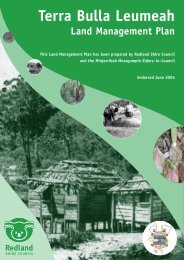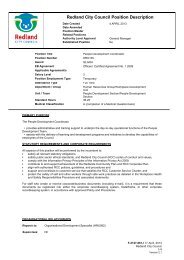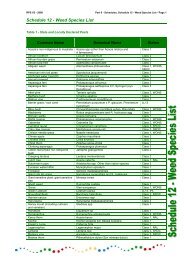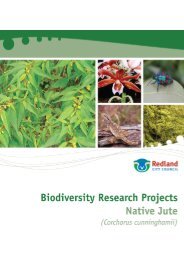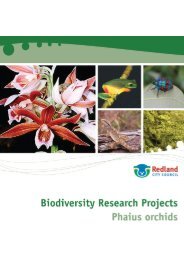Land for Wildlife Newsletter - IndigiScapes
Land for Wildlife Newsletter - IndigiScapes
Land for Wildlife Newsletter - IndigiScapes
Create successful ePaper yourself
Turn your PDF publications into a flip-book with our unique Google optimized e-Paper software.
practicalities<br />
Give Lantana the <strong>for</strong>ks!<br />
There would be very few rural properties<br />
in South East Queensland that could<br />
honestly claim a Lantana free status. I can’t<br />
think of another weed that is as prevalent<br />
in our landscape as Lantana camara. In<br />
my role as a <strong>Land</strong> <strong>for</strong> <strong>Wildlife</strong> Extension<br />
Officer one of the most commonly asked<br />
question I receive would have to be ‘..so<br />
what is the best way to get rid of lantana?”<br />
Un<strong>for</strong>tunately there is no short answer (and<br />
there is no silver bullet), but what is clear is<br />
that many landholders are looking <strong>for</strong> ways<br />
to make the task easier.<br />
Lantana is an extremely adaptable plant;<br />
it occupies a diversity of habitats and<br />
takes on varying growth <strong>for</strong>ms to meet<br />
specific local environmental conditions. To<br />
successfully control such a versatile weed<br />
you generally require an equally diverse set<br />
of tools, techniques and strategies.<br />
Recently I was shown an innovative new<br />
tool that has been designed specifically<br />
<strong>for</strong> manually removing lantana bushes.<br />
Over the last few years the ‘Lantana Fork’<br />
has been a work in progress <strong>for</strong> Cape York<br />
Nature Refuge Officer, Simon Thompson.<br />
Simon initially asked a colleague to make<br />
a big version of the garden weed puller.<br />
The first version did not have a foot which<br />
sort of worked, but it weighed about 20<br />
kg so it was easier to pull out plants by<br />
hand. Together they worked on improving<br />
the design and added a ‘foot’ in order to<br />
increase the lift potential but mindful of<br />
not compromising strength they used very<br />
thick (but heavy) steel. Simon explained<br />
that they gave this prototype a reasonably<br />
adequate field trial using the original<br />
design to pullout more than 250,000<br />
lantana plants from 40 Mile Scrub National<br />
Park!<br />
The Lantana Fork works by firmly clasping<br />
the base of the Lantana plant’s trunk (a<br />
prong on each side of the main stem) and<br />
then applying downward pressure on the<br />
long handle. The plant is then levered out<br />
of the ground, roots and all. Lantana Forks<br />
are now used all over Queensland from<br />
Cape York to south of Brisbane. Each time<br />
they have a new batch of <strong>for</strong>ks made at a<br />
local engineering workshop they tweak<br />
the design in an attempt to make it lighter<br />
without compromising the strength. Some<br />
of the advances have been shortening the<br />
<strong>for</strong>k to increase lift power and reduce the<br />
stress on the handle, adding supports to<br />
the back of the pole to stop it bending and<br />
adjusting the angle of the <strong>for</strong>k to make it<br />
easier to thrust into the base of plants.<br />
The latest version (see design below) uses<br />
lighter Bisalloy <strong>for</strong> the <strong>for</strong>k section, the<br />
pole and foot are made from steel pipe (2<br />
mm thick), the support <strong>for</strong> the foot is 10<br />
mm thick and the support along the back<br />
of the pole is 5 mm thick steel. Simon says,<br />
“It costs me $150 per <strong>for</strong>k to have made at<br />
a local engineering workshop, but there is<br />
nothing that couldn’t be done elsewhere.<br />
If someone finds a way to make it lighter<br />
without weakening it I’d love to know.<br />
Mine now weighs under 10 kgs. From our<br />
calculations it can produce between 350-<br />
700 kgs of lift, easily enough to unearth the<br />
roots of the toughest Lantana plant.”<br />
The Lantana Fork offers a great alternative<br />
<strong>for</strong> landholders that are looking <strong>for</strong> a nonherbicide<br />
option of controlling Lantana.<br />
I have also trialled it on saplings of other<br />
woody weeds such as Groundsel Bush,<br />
Camphor Laurel and Small-leaved Privet<br />
and it is effective when there is good soil<br />
moisture. The tool is probably best suited<br />
to Lantana bushes that have a shrub like<br />
growth <strong>for</strong>m (usually in drier more open<br />
<strong>for</strong>ests) than in areas where the plant has<br />
long runners at ground level.<br />
The Lantana Fork is not available<br />
commercially but Simon says he is happy<br />
if anyone wants to use the design to make<br />
their own so they too can give Lantana the<br />
<strong>for</strong>ks!<br />
150<br />
TOP VIEW<br />
80<br />
12<br />
300<br />
(<strong>for</strong>ks)<br />
35° 1800<br />
Steel pipe<br />
50mm<br />
approx<br />
50mm wide<br />
100 x 10 x 50 (foot support) 2mm thick<br />
900 x 30 x 5<br />
(back support)<br />
<strong>Land</strong> <strong>for</strong> <strong>Wildlife</strong> South East Queensland January 2013<br />
SIDE VIEW<br />
Article and photos by<br />
Nick Clancy<br />
<strong>Land</strong> <strong>for</strong> <strong>Wildlife</strong> Officer<br />
Sunshine Coast Council



